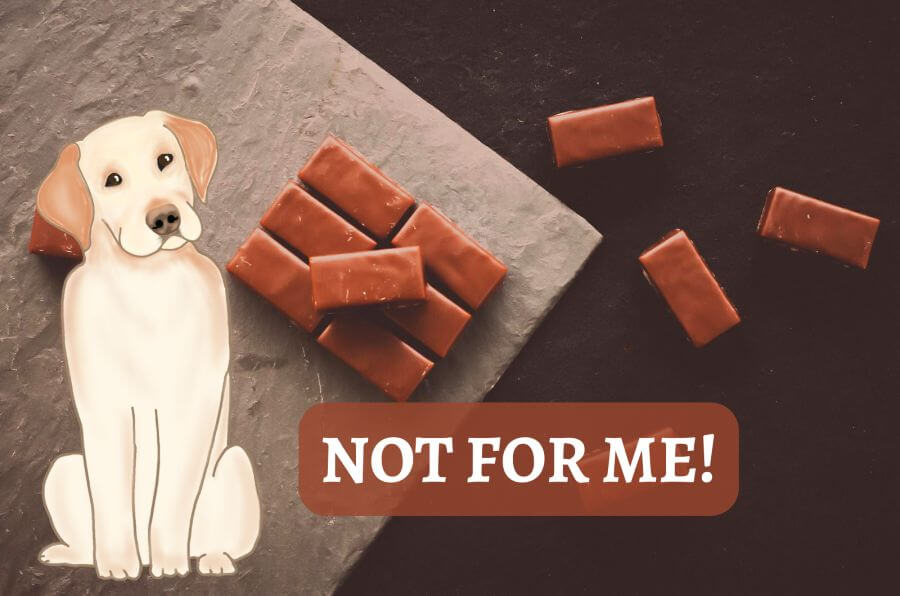Key Takeaways
- No matter how much your pup wants it, you should never give them chocolate!
- Chocolate, especially dark and baking chocolate, is incredibly toxic for dogs and can cause serious health problems or even death.
- Even small amounts of theobromine, a chemical compound found in chocolate, can lead to vomiting, diarrhea, increased heart rate, seizures, and even death.
- If you suspect that your dog has eaten chocolate – or if you know they have – it’s important to seek veterinary treatment immediately.
- If you can’t get your dog to the vet right away, you can try to induce vomiting at home with hydrogen peroxide.
Chocolate is made from the fruit of Theobroma cacao. These trees are native to tropical South America, but have been cultivated in other regions as well. The seeds are used to make cocoa butter and cocoa mass. These ingredients are then mixed with sugar, milk and other flavorings before being molded into the universally loved bars we know today. But can dogs eat chocolate?
Why Is Chocolate Toxic to Dogs?
Theobromine, the compound found in chocolate that is poisonous to dogs, is a xanthine alkaloid. Xanthines are a class of molecules that occur in many different plants, including coffee and tea. Theobromine is similar to caffeine, another xanthine alkaloid.

Both theobromine and caffeine are toxic to dogs because they can’t be metabolized by their bodies as well as by humans. This means that the compound builds up in a dog’s system over time, causing symptoms of toxicity such as vomiting and diarrhea.
Different Types of Chocolate Differ in Toxicity Levels
Can dogs eat chocolate? There is no such thing as “good” chocolate when it comes to dogs. All types of chocolate are poisonous and should never be given to a dog under any circumstance. There are, however, some levels to how bad they are.
Generally, the darker the chocolate, the more poisonous it will be for your pup. Dark chocolate and baking chocolate are by far the most harmful to canines. In fact, a 50-pound dog would need to consume just over one ounce of baking chocolate in order to be poisoned.
Milk chocolate contains less theobromine, but at the same time considerably more sugar and milk. White chocolate is the least toxic of all types because it contains less cocoa than both milk and dark varieties, but you still shouldn’t feed your dog this kind.
What Are the Symptoms of Chocolate Poisoning in Dogs?
The symptoms of chocolate poisoning in dogs can vary depending on the amount of chocolate they eat and the type of chocolate. Chocolate toxicity can be fatal for dogs because it causes them to have seizures and heart arrhythmias (irregular heartbeat). Theobromine also affects their kidneys, making dehydration more likely if they eat too much chocolate.

Some other common symptoms include:
- vomiting;
- diarrhea;
- increased heart rate; and
- death.
Signs of chocolate poisoning usually appear within 24 hours after ingestion and last up to 72 hours. If your dog has eaten any type of chocolate, contact your veterinarian immediately!
What to Do If Your Dog Ate Chocolate? First Aid
If you suspect your dog has eaten chocolate and there is no veterinary treatment available, you should induce vomiting as soon as possible. You can do this by giving them hydrogen peroxide orally or by making them drink a salt water solution. Activated charcoal in the form of tablets or powder may also be recommended to help absorb the toxins from the chocolate that have been digested.
Call the ASPCA Animal Poison Control at (888) 426-4435 to confirm what you should do. They can give you expert advice based on the amount of chocolate your dog has eaten.
Chocolate Alternatives for Dogs
It’s always best to err on the side of caution and not give your dog any chocolate at all! There are plenty of other treats available that are specifically made for dogs and are safe for them to eat. For example:
- Peanut butter: It can be used similarly to chocolate in baked treats and is great when mixed with carob.
- Pumpkin: This is a sweet and healthy treat for dogs. The vitamin A and fiber content helps with a dog’s digestion, making it easier for them to pass stool.
- Carob: This can be used to give your dog the taste of chocolate without any of the harmful side effects.
- Dates: A few of these are a great treat for dogs. They resemble chocolate and are a good source of selenium, magnesium, and iron.
Always do your research before feeding a new treat to your dog, especially if the treat is supposed to taste like chocolate. This way, you’ll know that it’s safe and healthy!
Can Dogs Eat Chocolate? Final Verdict
In conclusion, can dogs eat chocolate? We’ll repeat once more for the people in the back: no, chocolate and dogs do not go together. Dogs can’t digest theobromine, which is a chemical compound found in chocolate and makes up about 2% of cocoa powder. Even small amounts of this sweet treat will cause vomiting or diarrhea for your pup, not to mention in extreme cases it can prove lethal.
Similar Posts:
- Can Dogs Eat Oreos? Toxic Ingredients in Oreo Cookies
- Can Cats Eat Chocolate? Chocolate Toxicity in Cats
- Can Dogs Eat Macadamia Nuts? Symptoms of Macadamia Nut Poisoning in Dogs
- Can Dogs Eat Onions?
- Can Dogs Eat Cake | Dog Birthday Cake Recipes
- Can Dogs Eat Raisins? Do Raisins Cause Poisoning?
- Can Dogs Eat Pancakes? Are Pancakes Safe for Dogs?
- Can Dogs Eat Poppy Seeds? What Is Poppy Poisoning?

